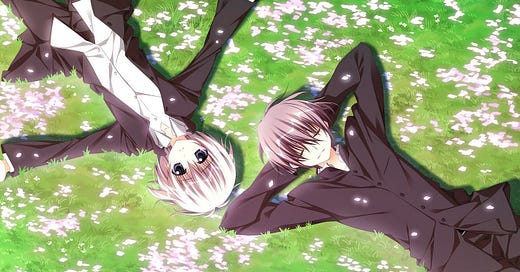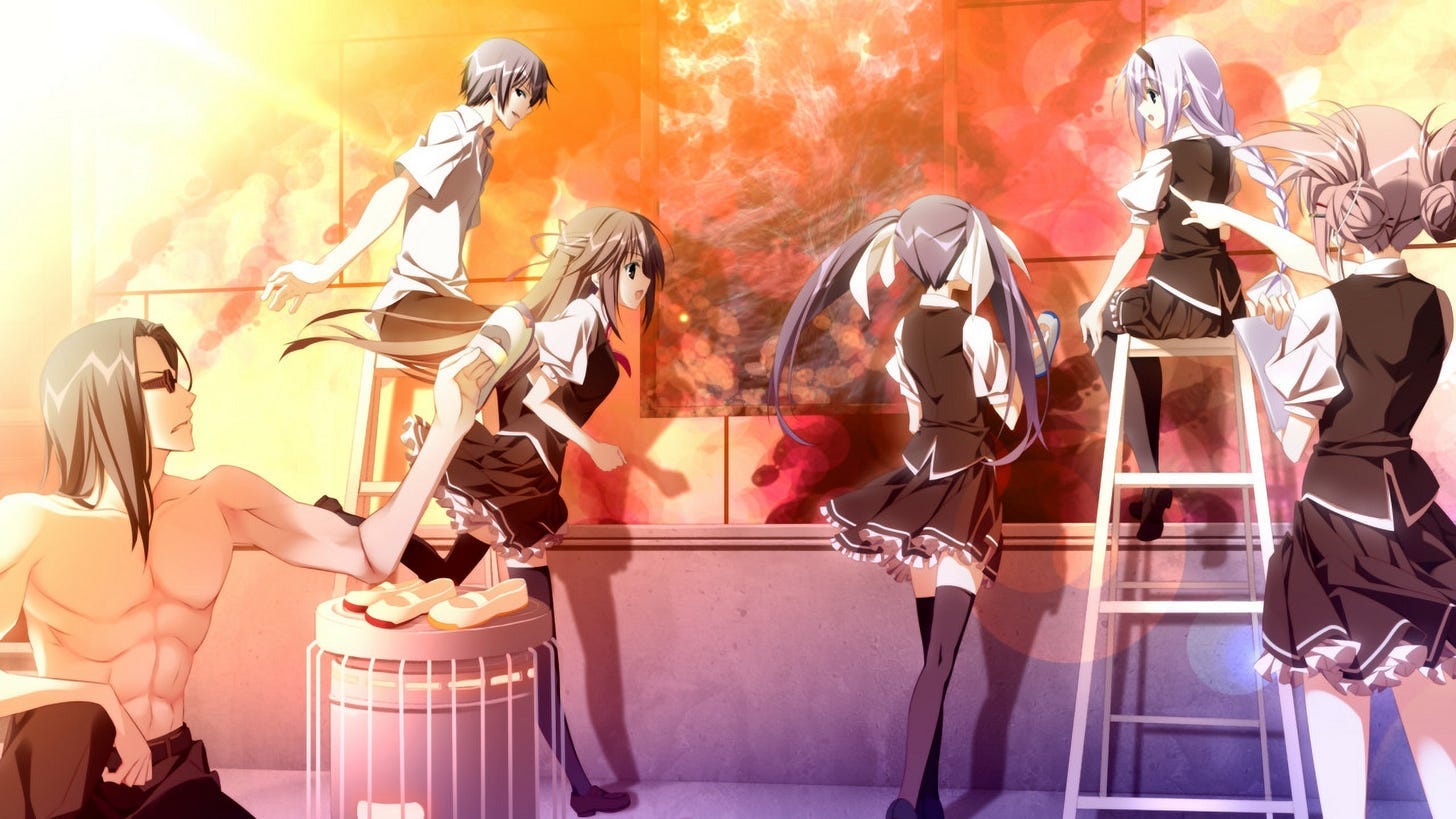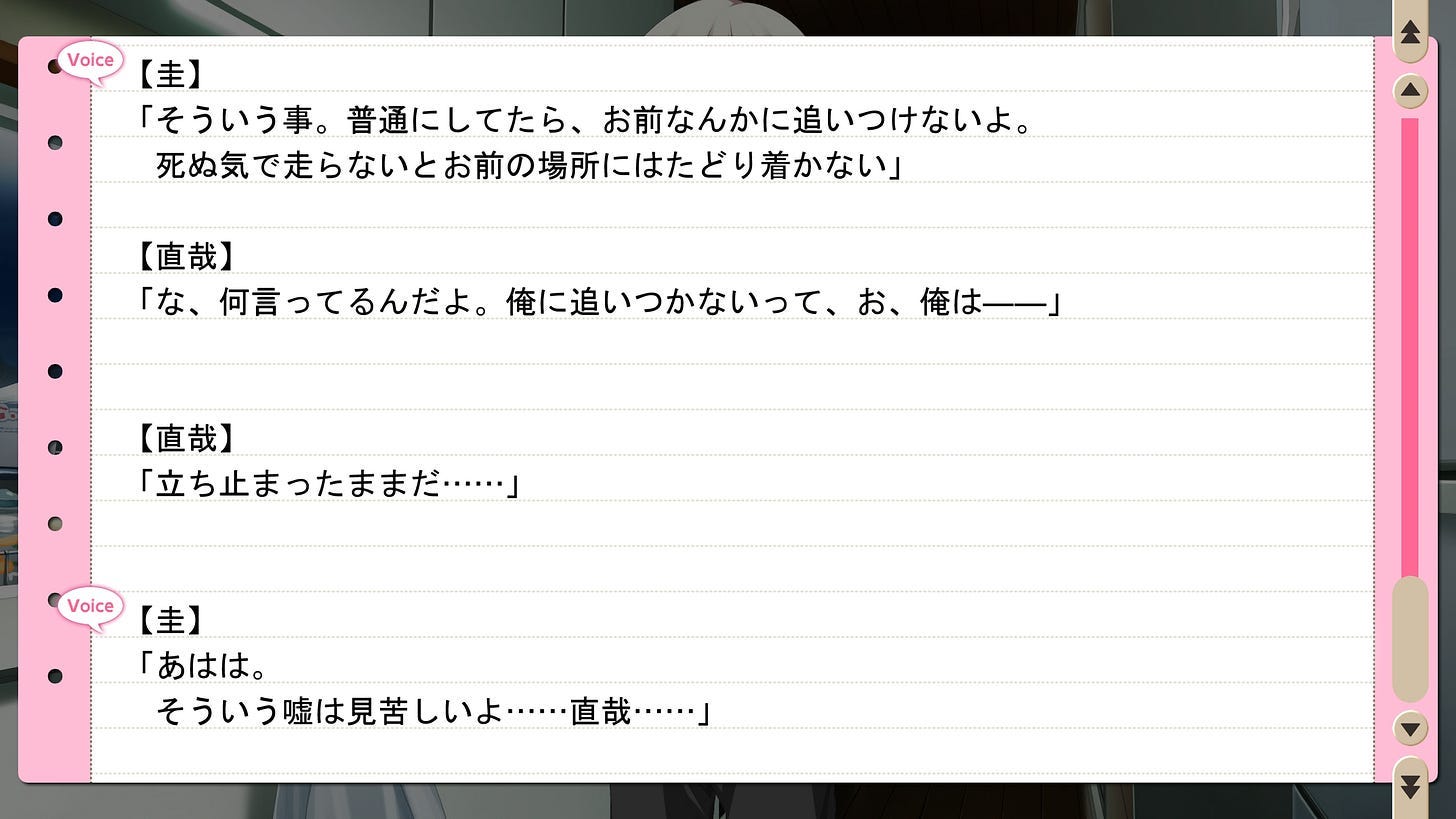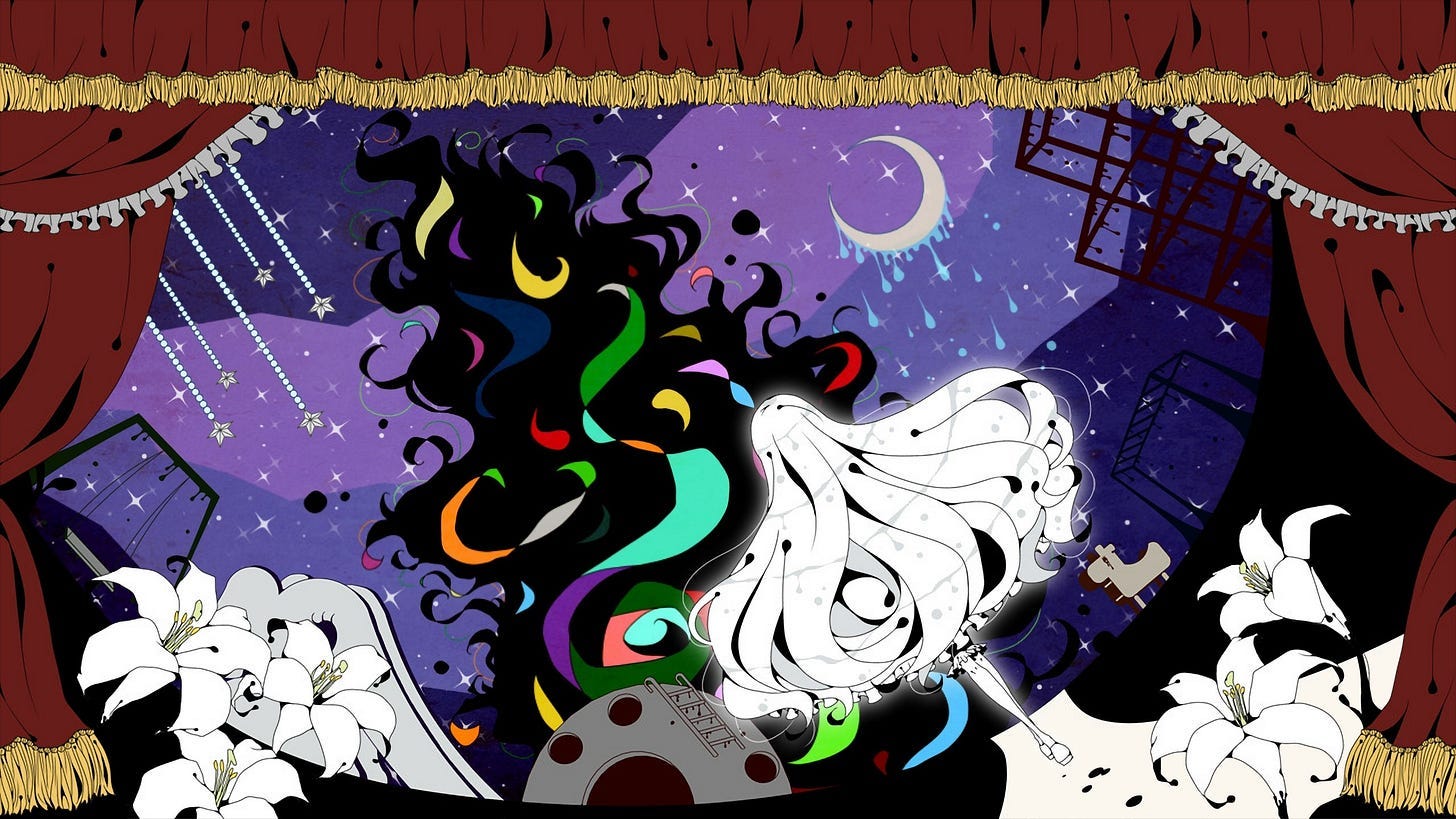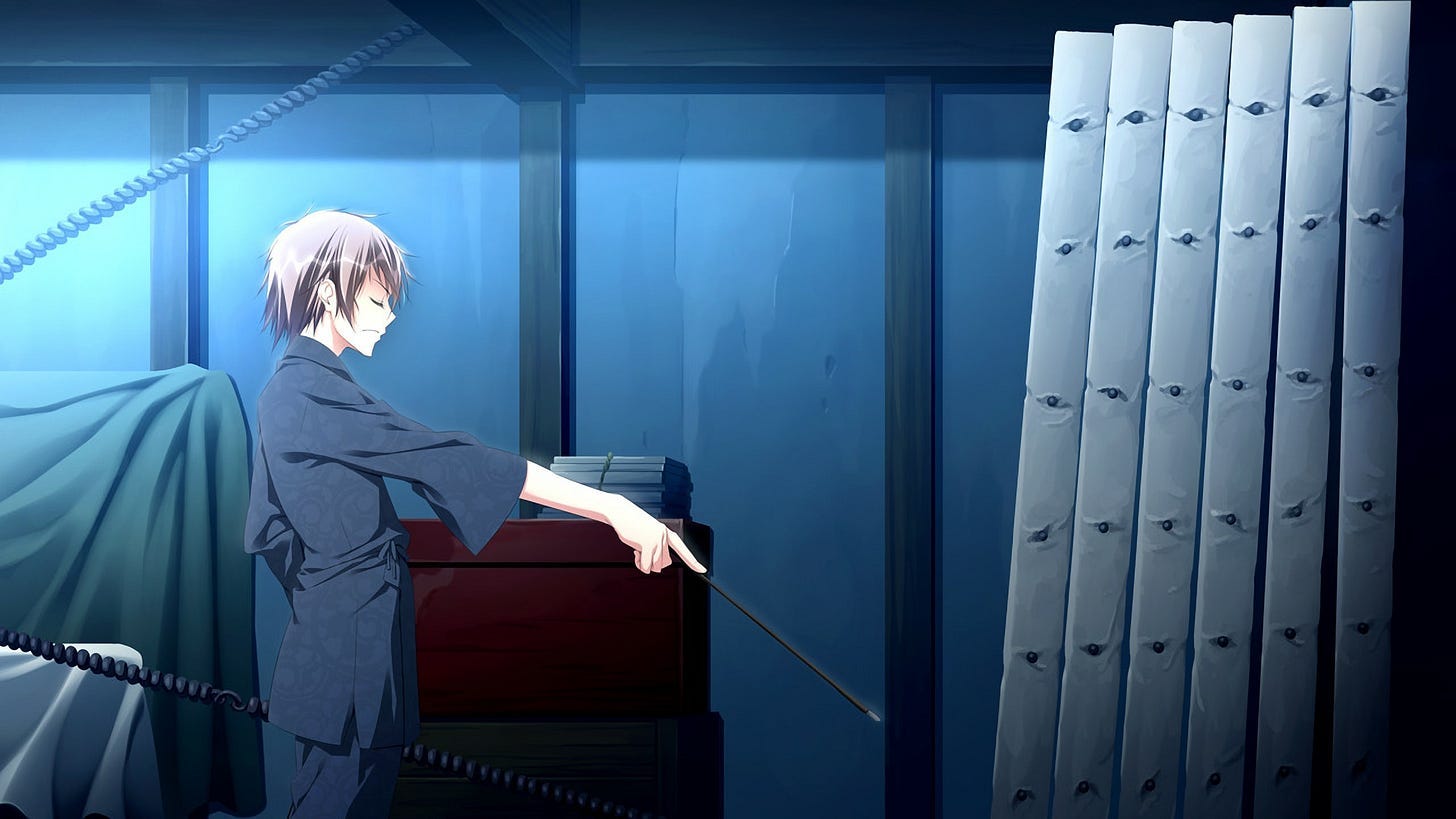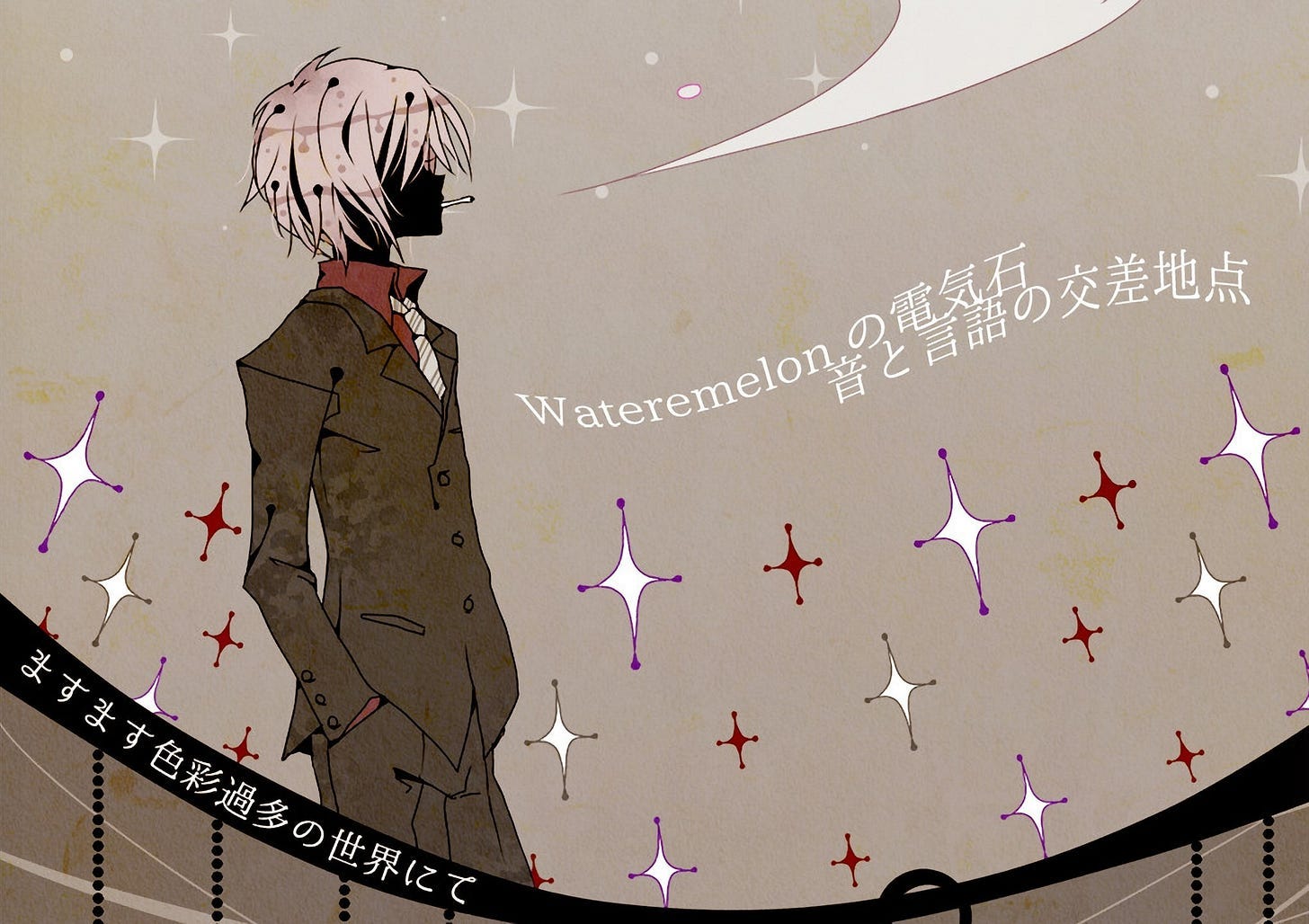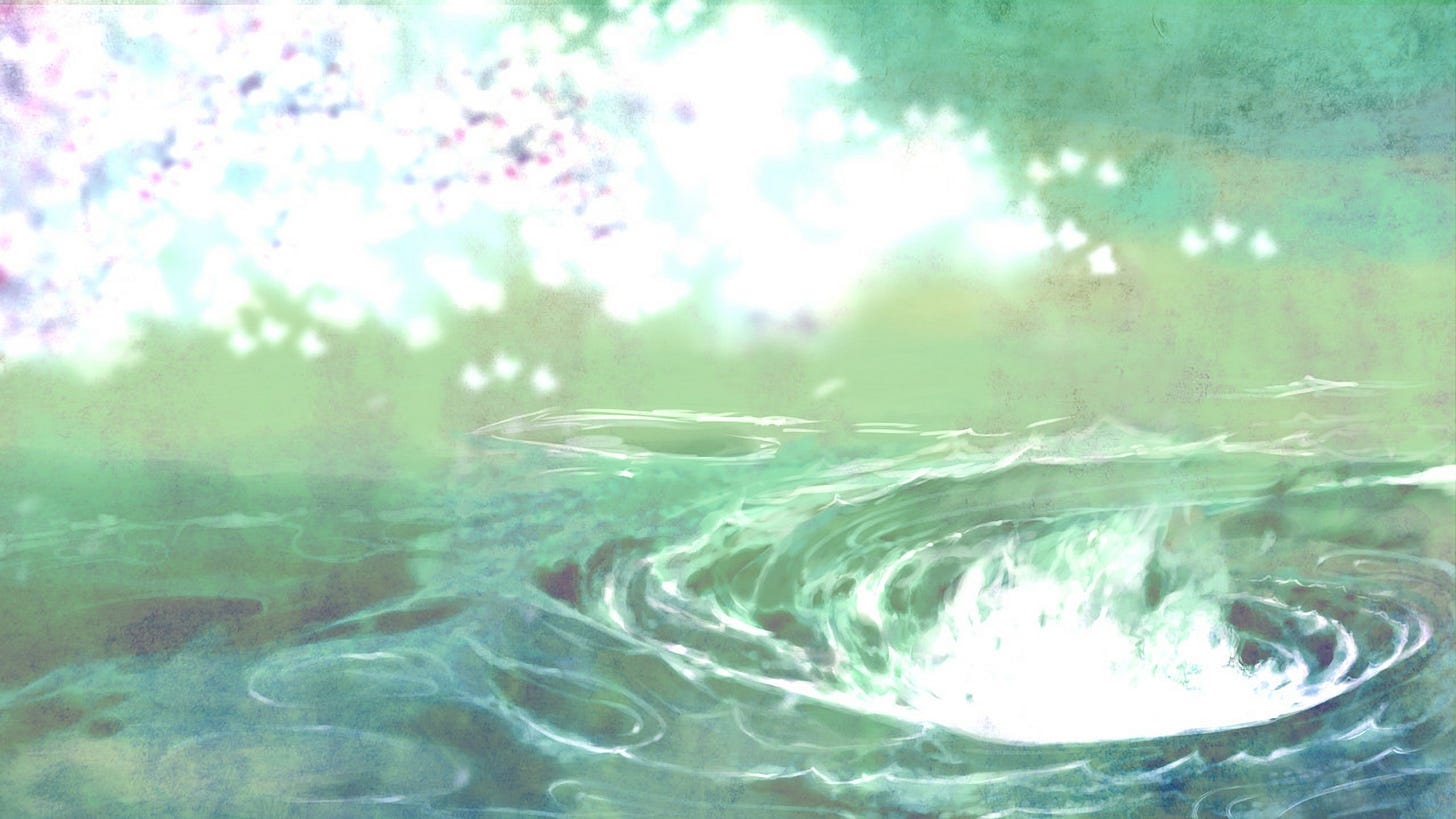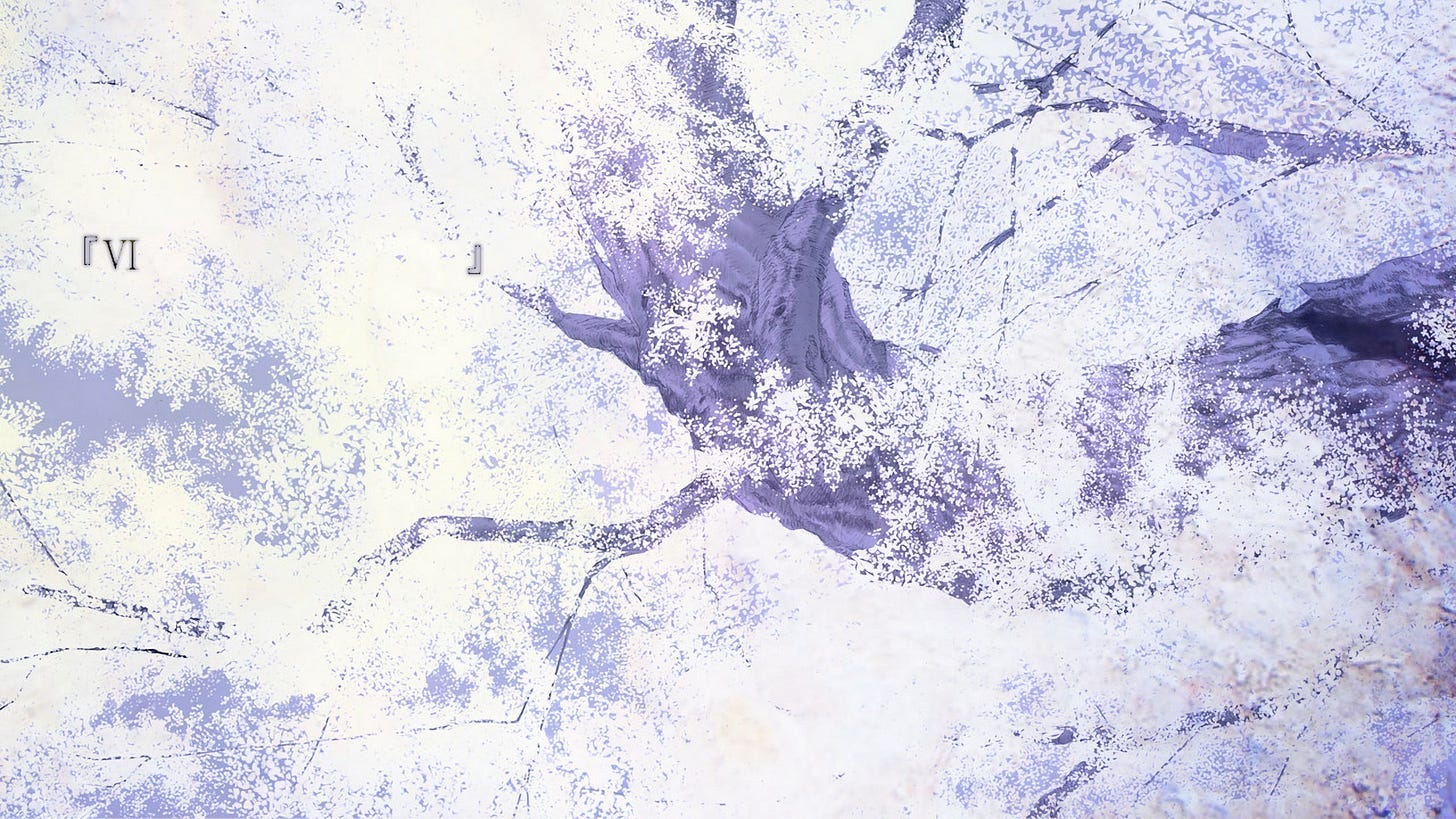(There will be some minor spoilers but I’ll do my best not to reveal too much)
This is going to be a bit different from my usual reviews and be more of a collection of my thoughts in chronological order. I generally don’t like writing them like this but I think this is the most natural method for this story.
Some background: around 8 years ago was my first encounter with Sakura No Uta. It was through the opening movie which I had stumbled upon on YouTube. The experience is what I imagine love at first sight must be like. Thus began an obsession which hung over my consciousness for the past third of my life. I’ve spent a long time fantasizing and silently worshipping just the idea of this work, something which I fully understand is a recipe for disaster and yet I still let my imagination run wild. I learned an entire language and read a multitude of books and related media just in preparation for what I’ve forever considered to be the magnum opus of its medium.
The reward for my senseless worship was one of the most profoundly beautiful experiences I have ever had. A continuous climb upwards allowing its reader a small glimpse into the pinnacle of artistic representation.
I’ve often read complaints about the first few chapters. How they’re riddled in an onslaught of dirty jokes and uninteresting pacing. But for me these are essential moments in introducing and building up the core themes of what Sakura No Uta is all about. It lightly tackles the ideas of talent and value in a more grounded and less bombastic scenario, allowing these themes to bud without being overshadowed by the greater events of the story.
Pica Pica
Apparently Pica Pica, the first core route , is regarded as one of the weakest but for me it’s the perfect opener to these ideas. The main heroine of this story, Makoto, ends up serving as a vessel for another key character, Kei, in a brilliant display of parallelism. This route is the first of many to tackle the ideas of perception of value and burden of talent, for those with and without it. Makoto, like Kei, is a workaholic. She feels she has to work a hundred times harder to be worthy of her title of president of the art club because if she didn’t she would be overwhelmed by the talent of its members. In particular the object of admiration, as well as a bit of contempt, comes in the form of the story’s protagonist: Naoya. Naoya is a tried and true genius, he is the son of a famous painter and has already risen to minor celebrity in artistic circles. Due to an accident in his childhood he is no longer able to paint as well using his right hand but the impact has already been set. For Makoto, Kei, and really every single character in this story, Naoya represents the artistic ideal. A paragon of talent who despite not actively pursuing artistic endeavors anymore stands head and shoulders above his peers.
Roughly translated conversation between Kei and Naoya.
Kei: That’s the problem. I’m very familiar with just how talented you are
Naoya: What’re you talking about
Kei: I’m saying It’s impossible for me to catch up unless I run at full speed.
Naoya: Full speed?
Kei: That’s right, I’m normal. When I chase after you I need to run to the brink of death, if I don’t I will never catch up to you.
Nayoa: What are you talking about? Chasing after me I’ve… Been standing still
Kei: haha, that’s a pitiful lie… Naoya.
This exchange happens in a much later chapter but the ideas have been seen as early as the first. It’s a key representation of how the world, and in particular Makoto and Kei, perceive talented people like Naoya. A countless ordeal of work just in the hopeless effort of catching up to who they determine to be their ideal.
Makoto’s route may not feature much of Kei, in fact none of them do until the very end, but what it does do is establish the key conflict between those with and without talent. Much of her route is rich in juxtaposition. Naoya is constantly seen slacking off on the rooftop, cutting classes and needing to take remedial lessons during the summer break. Meanwhile Makoto and Kei continue to work endlessly attempting to perfect their craft all alone. This is why I say they hold a little contempt for Naoya, their positions and philosophies in life are polar opposites, he holds the boundless potential while they are among laypeople, he never works hard while they toil away.
Their opposite nature doesn’t end there, it’s also used as a medium for the nature of perception. For Kei and Makoto, Naoya is described as their hero. He’s accomplished so much in so little time and has seemingly infinitely potential, and while some of it may have been stripped away there are glimmers of it lingering beneath the surface. Meanwhile Naoya simply cannot believe their words. Despite holding the superior position he is unable to grasp his own quality. This is another key dichotomy which is reiterated multiple times throughout the story: the conflict of value. Does the value of something come internally or is it something which is only attributed to you? In essence, this is the crux of Naoya’s struggle. The juxtaposition between his diminished talent and the expectations of the world around him lead to him becoming lost in the world. He does not understand value, because he thinks he no longer has ability; he cannot believe that he himself has value, despite how he is perceived by others.
From my brief readings of other people’s thoughts on Makoto’s route I think it’s severely underappreciated. Maybe because of it’s slower back end or because it doesn’t tie inasmuch to the remainder of the story, at least on the surface level, but it’s an essential piece of the story and easily rewards a more careful reader.
Olympia
The next route, Olympia, covers the other core theme of Sakura No Uta: grief and family. I actually consider this route to be the weakest. Although I actually do enjoy the humor it ends up stalling the progress of this route a bit too much and you’re left with a good, but fairly unpolished, experience. This route, when it gets going, delves into the grieving process as well as the struggles of familial relationships in single parent households. Rin acts in parallel to Naoya here as the core conflict revolves around the loss of her mother and how she copes with it.
Honestly there isn’t as much to say about this route, especially compared to Pica Pica, Rin doesn’t work as well as a vessel for Naoya as Makoto does for Kei for a couple reasons. The most obvious one is that we read everything, up to this point, through the perspective of Naoya whereas Kei rarely shows up outside of the beginning and end of the story. Additionally Rin’s initial character doesn’t provide as much insight as Makoto does, her main purpose in this route is to get the reader to think about the impact significant loss and an unstable family relationship has, the circumstances surrounding Rin are far more interesting than she is. Rin does end up being developed more in later chapters but for now she’s mostly a tool for consequence rather than coming into her own fully.
Despite all that, the process of grief is portrayed very well here. Rin has essentially disassociated any and all memory of her mother and restructured the past in an attempt to cope with what transpired. Initially I thought this would mirror Nayoa’s relationship with his father, which in a lesser extent it somewhat does, but it ends up being a lot more simple and direct than that. Through the loss of her mother, as well as this being the source of Naoya’s apparent loss of ability, Rin has reshaped herself into a completely different person. Similarly through the loss of his father Naoya has fallen even more into the groves of solitude. Both parties develop a self-deprecating attitude which envelops them and restricts their potential to move forward.
Olympia on its own does not accomplish as much as Pica Pica. The duality of Naoya and Rin is something which recurs throughout the remainder of the story but as of this point serves for little impact as neither character has been granted sufficient time to be fleshed out. This is a route which pays dividends to the reader, especially as you approach the end, but could have done with greater refinement.
Zypressen
The third and most technically impressive route. This is the route where things “get good” probably because it’s the route which allows itself to fully submerge itself in creativity. Right from the get go the perspective shifts and alternates between three main characters: Naoya, Rina, and Yuumi, something which hasn’t been done up to this point in the story. Naoya actually ends up taking the backseat for the majority of this route as the relationship between Rina and Yuumi is the main focus here. Zypressen ends up being the most self contained route in the story, Rina and Yuumi don’t end up showing up much outside of here and they leave little impact on any future events in the grand scheme of things.
That isn’t to say there’s nothing to be gained here. This route dives into unrequited feelings which is another minor yet prevalent theme. The route is split into two different sections, one which follows Yuumi’s desires and one which follows Naoya’s desires. Yuumi’s half steals the show easily. Almost the entire thing is a recitation of a poetic stage play which displays her feelings of adoration for Rina and disgust at the limitations bound to her due to them both being women. Interlaced are glimpses into their childhood where she’s forced to become painfully aware of the insurmountable distance between her and Rina as Rina becomes increasingly infatuated with Naoya.
Yuumi’s half is rich in artistic merit. Rather than display these feelings through the standard background they instead make the most of what they have and transform the entire thing into a play itself. You’re treated to some of the most beautiful visuals in the entire story which pair with the melancholic tone of Yuumi’s words. The words appear in disjoint fashion, not in the standard left to right but all over the text box, reflecting the scattered and somewhat aggressive process of her mind. Her recitation is hollow and yet every word sucks you in. It’s truly a one of a kind experience that I certainly cannot do justice.
Rina’s route ends up being more standard although the story ends up being interlaced by an alternative fictional story of a girl and her lover and their unrequited love in feudal Japan. These sections don’t end up having the same impact as the stage play of Yuumi but serve a similar purpose in enriching the purpose of this route. Coming off of Yuumi’s half it leaves a bit to be desired but this is more than made up for by the closing remarks by Yuumi, as she beautifully recites a section from Flower and Asura
(I’m not going to translate it but there are many online)
In case you’re unfamiliar, zypressen refers to cypress trees which are often symbols of death. In this case the connotation refers to the symbolic death of Yuumi’s adoration for Rina as she is ultimately unrequited. The feeling of being unrequited ends up tangentially feeding into many other characters' arcs, notably Kei and Makoto in their chase of Naoya’s talent. Zypressen as a chapter may not ultimately contribute much to the overall story but it has significant value in helping the reader comprehend the overall themes. If nothing else it’s an incredibly beautiful nonstop performance rich in literary and visual creativity and is far and away the most “complete” of any individual route.
A Nice Derangement of Epitaphs
If Zypressen was the most independent route than Epitaphs is the completion of everything which came before it. I’ve specifically been using the word “route” here because everything covered thus far has fallen under the blanket of chapter 3 and are simply alternate situations which could occur rather than a chronological series of events. Epitaphs follows in the footsteps of Zypressen and constantly alternates between past and present as it tells us the story of not only Shizuku but more importantly Naoya’s father: Kenichiro.
Up to this point I had assumed Kenichiro had probably been a bit of a prick, maybe he didn’t support his son as much or he had some sort of personality issues. So it was my pleasant surprise when on his first appearance he leaves one of the most positive first impressions of any character in the story. He’s this lively aging man who takes his illness in stride and is the light of the room. Chock full of charisma he swiftly became one of my favorite characters in the entire story despite his extremely limited screen time.
The route as a whole signals a shift in storytelling, no longer are themes introduced but they are being addressed and developed by the cast itself. Here especially we obtain a far richer understanding of the meaning of value. Kenichiro is a man who wholly understands what value is. He has the mark of a true artist, a man who lives entirely for himself. Value is not extrinsic for him, it’s entirely intrinsic, his work and his life are not defined by any observer they are defined by nobody but himself. This does not make him a selfish person, in fact he sacrifices a lot in the moments before he dies in order to secure a future for his son, despite how this may make Naoya think of him. Kenichiro represents the artistic ideal, a man who determines that a thing can only truly be appraised independently of anyone else.
Kenichiro does his best to demonstrate this to a younger Naoya in their final interactions before he meets his inevitable death, leaving Naoya with conflicting feelings about the man. Unable to truly resent him, unable to truly respect him, unable to truly live up to his name, the impact and lack of satisfaction that Kenichiro imprints on Naoya through his life and death define who he is and are the culmination of every prior route. The relationship that they share is immensely powerful, the seeds planted have now bloomed into an entire story and it’s one of the single greatest moments in the entire story.
If there’s a problem in this route, it’s that Shizuku ends up being overshadowed by Kenichiro as they ultimately share a joint route. It’s a shame because Shizuku was my second favorite (girl) character going into this route. While the development that she ultimately receives isn’t too bad it pales in comparison to the tempest that is Kenichiro. The Shizuku sections mainly serve to push Kenichiro and surprisingly Rin forward and she does this well, especially for Rin who was definitely in need of more development even after her own route. Her relationship with Rin ends up being incredibly important though mainly as foreshadowing for the sequel. As always Rin ends up being a slow burn character who pays off in increments rather than all at once.
Other than that, Epitaphs serves as the solution to everything which preceded it. The reader has now been granted all of the pieces of the story and is now finally allowed to move forward.
What is Mind? No Matter. What is Matter? Never Mind.
Or so I would like to say but here we have a very short prologue chapter which only serves to complete Kenichiro’s character. For the most part there isn’t too much to say. It gives him a stronger argument for his motivations as well as introducing us to his late wife who is the foundation to his philosophy. There isn’t much to complain about with this chapter but there also isn’t much to comment on either. It’s short and wraps things up nicely.
The Happy Prince and Other Tales
Words cannot do this chapter justice. The easiest and most accurate way to put it is that it’s pure beauty.
Epitaphs gathered all of the ideas into one place and now The Happy Prince is going to take all of them and bring them to their natural conclusion. This route completes Naoya by forcing him to confront the challenges which have plagued all of the other members of the art club. His unrequited feelings towards his previous talent, the insecure nature of his own value, the veil which his father has cast over him through his death. All of these issues have steadily been brewing within him and now they shall be brought to light.
Kei finally makes his reappearance in this chapter and the central conflict mainly revolves around him. The example I provided in Pica Pica takes place here as Kei spends every waking moment of his life holed up in his atelier working on his art. Desperately chasing after Naoya, his hero. Naoya is finally forced to confront the contradiction between how others perceive him and how he perceives himself. Seeing Kei work himself to death, in an act of stubbornness he finally picks up a paint brush once again almost in an attempt to prove that he does not in fact have talent.
What follows is a complete resurrection. At first only egged on by Kei and bystander Kana — a character I haven’t brought up but she’s basically just a bitch in every scene she shows up in, she represents the antithesis of the intrinsic value perspective — he sinks further and further into his old talent pool. Eventually coming out the other end with a greater understanding of who he really is and what it means to be an artist.
This eventually leads into the strongest challenge to the debate of value yet. The greater art community. This is introduced a little in earlier chapters such as Epitaphs but comes out in full force here. When Naoya and Kei’s art are nominated for the same award on the global stage this introduces the strongest counterargument to the values which Kenichiro held. Here, art is put on a pedestal to be appraised and judged, whichever is deemed to have a higher sales price is the piece which is better. Although this can also be called appreciating art, it’s also a complete reduction of art.
The greater art community’s obsession with the marketability of art rather than the inherent value of art is something which is addressed multiple times in Sakura No Uta and it’s especially clear in this route. While this methodology does often end up selecting the highest quality art, what about the art which remains unseen? I think my stance on the topic is clear but to be perfectly honest either side is nearly equally valid. An artist who only works for themselves without an extrinsic
motivation may never end up creating anything of public value, but an artist who only works for the public may never end up achieving self fulfillment.
Rin and Naoya end up having a conversation in the concluding moments of this route entirely about this topic. Rin brings up various works most notably of Emily Dickinson, one of Sca-Ji (the authors) favorite poets, and how she spent the bulk of her life holed up in her room writing poems for nobody but herself. Now Dickinson is revered as one of the greatest poets to ever live. There are countless stories like this. Geniuses who create solely for themselves, because they like to, because they feel it’s what they have to do. Often only after their death are they brought to their rightful reputation among masters in the public eye, but for them the only thing that mattered was that they were doing it for themselves. That’s the mark of a true genius, a person who has become inseparable from their craft.
「 」
The final chapter. An epilogue following a fairly significant timeskip after the events of the previous chapter. Similar to Chapter 4 this mostly serves as a chapter which ties up loose ends as well as leading into the sequel. Here we witness a now adult Naoya who has been able to find a purpose in life. He has come to terms with the lessons found in his fathers life and in some ways has begun to mirror his behavior.
This is best represented through the central conflict of this chapter which ends up being the graffiti of the mural which Naoya and the members of the art club worked on. It’s stood the test of time as a landmark of his school and his club’s efforts and the defamation of it has caused an uproar among his students. Interestingly Naoya just… doesn’t care. And this is where it is. Naoya expressed his complete understanding of what it means to be an artist. They can do whatever they want to his art because he created it simply for himself. It’s value is not tied to it’s existence on the wall, the name attached to it, or the value it brings to the academy. It’s not tied to anything but the sheer process of creation itself. It’s an incredibly profound and satisfying moment that ties the entire thematic conflict to a close.
There’s a good amount of similarities to the previous chapter here which aren’t really worth bringing up a second time, notably with the greater art community/committees, but this chapter serves as a close to Naoya’s long journey and a transition into the sequel where he will hopefully impart this knowledge into the next generation of artists.
Concluding Thoughts
Sakura no Uta is an honest, beautiful work. It’s a steady climb upwards that never manages to lose track of its ideas leading into some of the greatest emotional releases in the medium. The word soul gets thrown a lot in some pretentious circles but I think it’s completely apt here. Where else would you find a work which is relentless in throwing in dirty jokes every other line — seriously I think オナに (masturbation) is one of the most used words — and still manages to emotionally destroy it’s readers? In some ways this creates a meta narrative, by making the work so abundant in that sort of humor it illustrates that this really is a work that Sca-Ji made for himself, uncompromising for anyone else.
It’s worth noting that this is a passion project through and through. The music is seriously one of if not the best soundtrack to a visual novel ever. Every single song fits the scenario perfectly and is rich in beauty. Even before I read it there’s a few songs which upon hearing I experience full body chills or start crying, it’s seriously incredible stuff. Additionally the insert songs (songs that play during the credits) are all incredible and fit the themes of the chapter perfectly. Singers Hana and Monet do a fantastic job in their vocal performances wrapping their listeners in pure emotion.
Additionally the art style is incredible. I’ve attached a few of my favorite images at the end of each chapter but the work that they’ve done here is simply jaw dropping. It goes without saying but when making a work about art it seriously helps when you yourself are able to produce incredible art. The work I attached at the end of the final chapter is one of my personal favorites. There are some moments in which I wish they included more, especially given the lengths they describe certain pieces without explicitly showing them, but I also acknowledge that that’s a pretty greedy sentiment to have and I am greatly thankful for what they’ve provided.
I’m thankful to have read this work and I hope I’ve done a good enough job explaining why. I’ve spent the last third of my life building this experience up and it still managed to exceed any expectation I set. A life changing work.

